Intel's Bean Canyon (NUC8i7BEH) Coffee Lake NUC Review - Ticking the Right Boxes
by Ganesh T S on April 3, 2019 8:00 AM EST- Posted in
- Systems
- Intel
- NUC
- UCFF
- Thunderbolt 3
- Cannon Point
- Coffee Lake-U
GPU Performance for Workstation Workloads - SPECviewperf 13
The SPECviewperf benchmark from SPEC provides an idea of the capabilities of the GPU in a workstation from the perspective of different CAD, content creation, and visual data analysis tools. It makes more sense to process these benchmarks on workstations with professional GPUs, but, consumer GPUs are often the choice for machines that need to handle both gaming and professional workloads.
SPECviewperf 13 includes nine different workloads representative of graphics content and behavior of actual applications. They make use of the OpenGL 4.0 and DirectX 12 APIs under Windows. SPECviewperf 13's workloads (termed viewsets) can officially be run only at two desktop resolutions (1920 x 1080, and 3840 x 2160), and need the dsplay scaling to be set to 100% (DPI of 96). The available viewsets are listed below.
- 3ds Max (3dsmax-06)
- CATIA (catia-05)
- Creo (creo-02)
- Energy (energy-02)
- Maya (maya-05)
- Medical (medical-02)
- Showcase (showcase-02)
- Siemens NX (snx-03)
- Solidworks (sw-04)
The 3ds Max and Showcase viewsets are available only when processing at 1920 x 1080. The rest are available at both resolutions.
We processed SPECviewperf 13 at both resolutions on the Intel NUC8i7BEH (Bean Canyon). The benchmark measures the frame rate at which the GPU renders the scenes in a viewset. Each viewset is composed of different scenes and rendering modes, and the composite score for the viewset is a weighted geometric mean of the FPS measured for the different scenes. In this section, we take a look at how its composite scores stack up against other systems targeting this market segment.
3ds Max (3dsmax-06)
The 3dsmax-06 viewset comprises of 11 different scenes. They have been created from traces of the graphics workload generated by Autodesk 3ds Max 2016 using the default Nitrous DX11 driver. Additional details are available here.
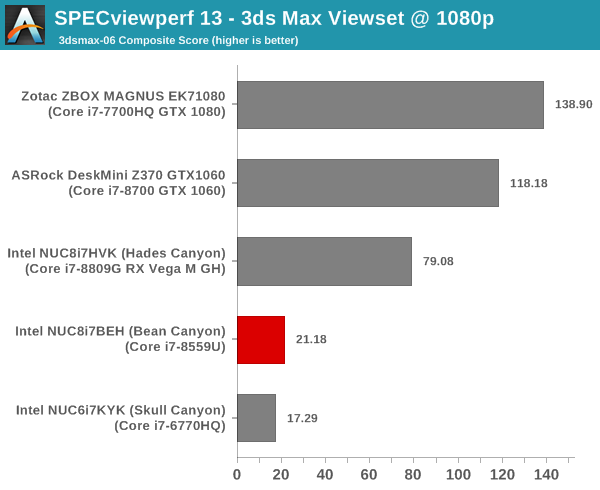
The ordering of the numbers is very similar to what was seen in the previous section.
CATIA (catia-05)
The catia-05 viewset comprises of 14 different tests created from traces of the graphics workload generated by the CATIA V6 R2012 application from Dassault Systemes. Additional details are available here.
| SPECviewperf 13: CATIA Viewset Composite Scores | |||
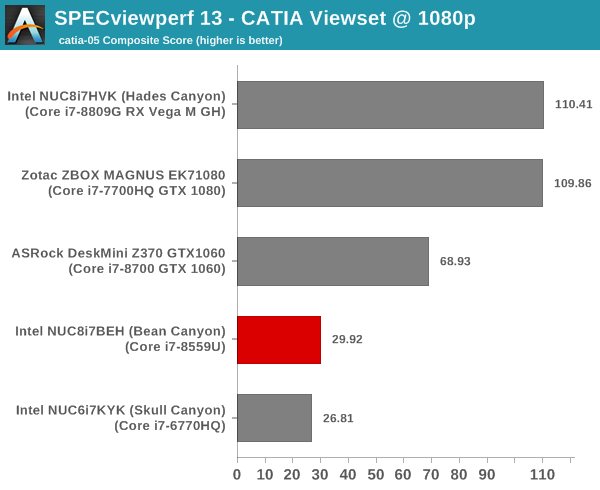
The Bean Canyon NUC is slightly ahead of the Skull Canyon, but the discrete GPU-equipped systems are much further ahead.
Creo (creo-02)
The creo-02 viewset comprises of 16 different tests created from traces of the graphics workload generated by the Creo 3 and Creo 4 applications from PTC. Additional details are available here.
| SPECviewperf 13: Creo Viewset Composite Scores | |||
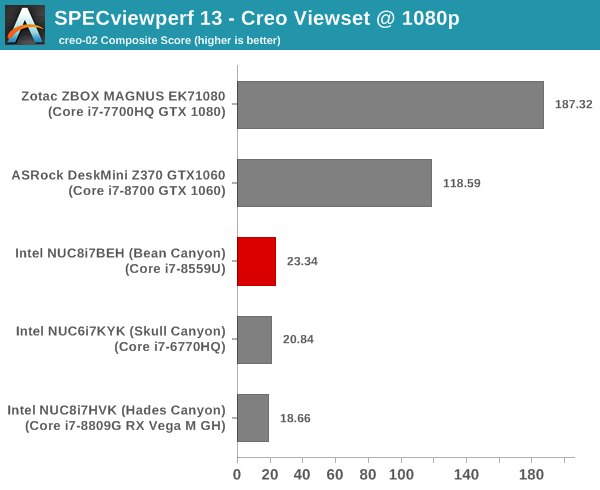
Energy (energy-02)
The energy-02 viewset comprises of 6 different tests based on techniques used by the OpendTect seismic visualization application. Additional details are available here.
| SPECviewperf 13: Energy Viewset Composite Scores | |||
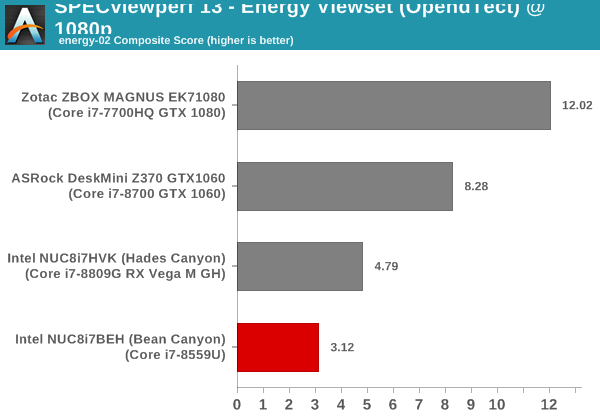
Given that the energy-02 workload didn't complete at all on the Skull Canyon NUC, it is heartening to see that the Bean Canyon NUC can at least finish processing the benchmark.
Maya (maya-05)
The maya-05 viewset comprises of 10 different tests based on traces of the graphics workload generated by Autodesk Maya 2017. Additional details are available here.
| SPECviewperf 13: Maya Viewset Composite Scores | |||
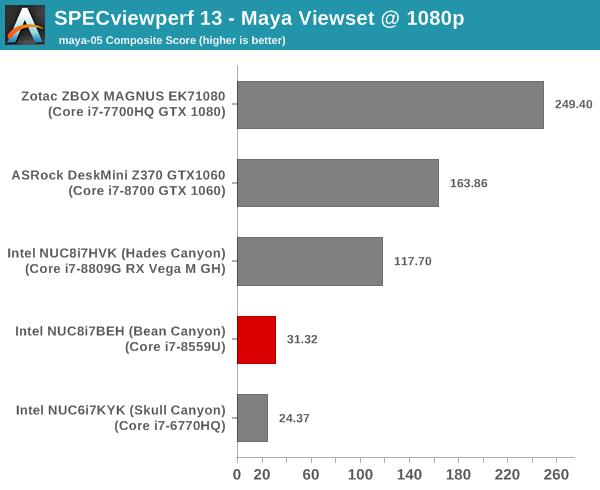
Maya takes us back to the regularly scheduled programming - Bean Canyon is ahead of Skull Canyon, but, trails everyone else.
Medical (medical-02)
The medical-02 viewset comprises of 8 different tests derived from 4 distinct datasets. Each test uses the ImageVis3D volume visualization program's Tuvok rendering core for 2D projections of 3D volumetric grids. Additional details are available here.
| SPECviewperf 13: Medical Viewset Composite Scores | |||
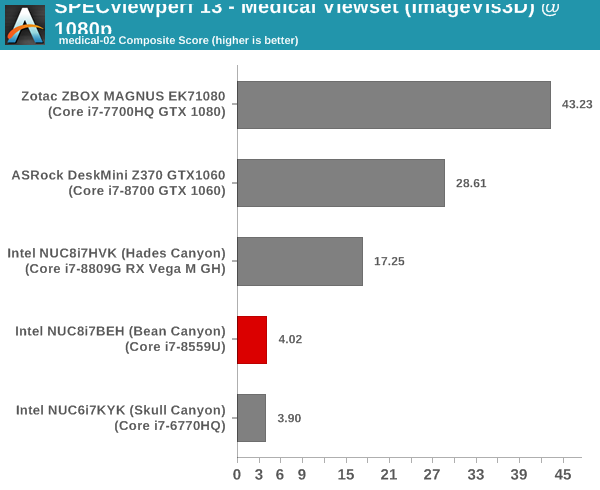
Showcase (showcase-02)
The showcase-02 viewset comprises of 4 tests created from traces of the Autodesk Showcase 2013 application rendering a racecar model with 8 million vertices using different modes. Additional details are available here.
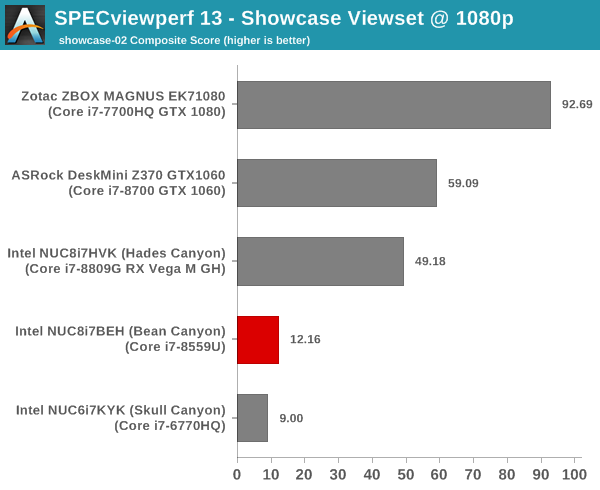
Siemens NX (snx-03)
The snx-03 viewset comprises of 10 tests created with traces from the graphics workload generated by the NX 8.0 application from Siemens PLM. Additional details are available here.
| SPECviewperf 13: Siemens NX Viewset Composite Scores | |||
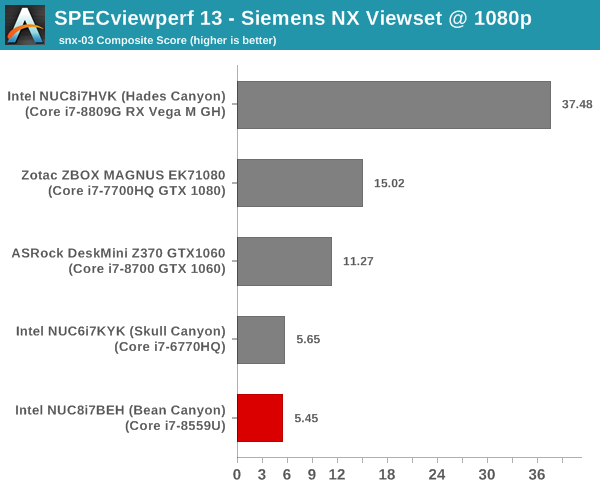
Solidworks (sw-04)
The sw-04 viewset comprises of 11 tests created from traces of Dassault Systemes’ SolidWorks 2013 SP1 application. Additional details are available here.
| SPECviewperf 13: Solidworks Viewset Composite Scores | |||
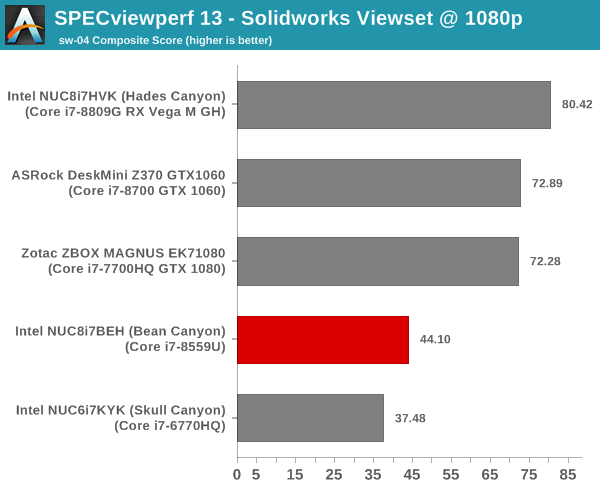
Overall, we see that Bean Canyon has limited use for processing SPECviewperf-type workloads. However, the presence of a Thunderbolt 3 port means that users can always attach a professional GPU in a eGFX enclosure to process these types of tasks.










81 Comments
View All Comments
DimeCadmium - Thursday, April 4, 2019 - link
You do realize the skull doesn't have to be visible?PeachNCream - Thursday, April 4, 2019 - link
It's not just the morbid case cover that bothers me. The fact is that the brand name in general is something that discourages my interest in an otherwise solid computing device. I don't need death or bones or corpse-like branding on my computer parts. That kind of thing has a way of crawling into your head and sticking around in there. It may seem trivial, but to someone that has had to see and deal with real world violence, it just isn't something I want associated with something I use for work and play at home.GreenReaper - Thursday, April 4, 2019 - link
What I want to know is this: where are all these canyons? Time was, codenames were based on actual locations, but nowadays I'm not sure. There's nothing on Google Maps...mikato - Thursday, April 4, 2019 - link
Me too. And if Bean Canyon isn't a real place, then I can't understand how such a ridiculous name would be used for a CPU.MrCommunistGen - Wednesday, April 3, 2019 - link
I'm not at all disagreeing with your point -- Intel has made pretty substantial gains in efficiency -- but we should all just remember that the CPUs in both systems are probably blowing WAY past their TDP (non-turbo) ratings to achieve the performance we're seeing in these benchmarks.MrCommunistGen - Wednesday, April 3, 2019 - link
I kept not finding the Power Consumption figures in the article. Under a full CPU + GPU load it looks like Bean Canyon is pulling ~72W at the wall and Skull Canyon is pulling ~77W at the wall.Still impressive since Bean Canyon tends to be a bit faster and has a smaller GPU configuration.
IntelUser2000 - Wednesday, April 3, 2019 - link
Skull Canyon just sucks. It should be performing 30-50% faster than this one. No wonder nothing outside of a single Intel NUC used it. The previous two Iris Pros sucked too. Each generation made it worse.FATCamaro - Wednesday, April 3, 2019 - link
These make a Mac mini look like a deal.cacnoff - Wednesday, April 3, 2019 - link
Ganesh,"Perhaps an additional Thunderbolt 3 controller directly attached to the CPU's PCIe lanes could make the platform look even more attractive."
This is a 14nm U-Series Part, there are no CPU PCIe lanes on it. Maybe complain about the U-Series parts not having pcie on the cpu package rather than about the NUC not having a feature that is impossible to support.
jordanclock - Wednesday, April 3, 2019 - link
You sure about that? Ark pretty clearly lists the 8559U has having 16 PCIe lanes.